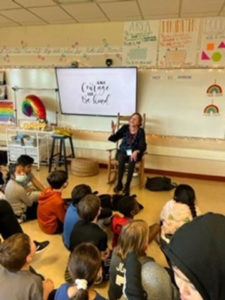
Luna and I had a great time at Oak Terrace.
This past Tuesday Seeing Eye dog Luna and I had the honor of visiting third-graders at Oak Terrace Elementary school in Highwood, Illinois to talk about what it’s like to be blind and how service dogs help us get around.
Oak Terrace is a Spanish dual language school: students there are provided daily instruction in both English and Spanish. I am no expert in the benefits of bilingual education, but based on some of the words the kids used when asking questions, I’d say it really helps with vocabulary! Some examples:
- Did you just wake up one day and all you could see was black?
- Did you have previous experience with any other dogs before you got your first Seeing Eye dog?
- How do you eat, I mean, how do you use utensils?
- Were you terrified when you woke up and all you could see was the color black?
- How do you play video games?
- How do you eat when your husband isn’t around to cook?
- What if there’s a natural disaster?
- How do you swim without running into the wall at the end of each lap?
- How do you use the bathroom?
- Do you choose what to wear, or do you just pick your clothes at random?
- How do you drive?
- What happens when your dog retires?
”At random?” “Terrified?” “Natural disaster?” “Previous experience?” “Utensils?” What sort of eight-year-olds use sophisticated language like that?
Eight-year-olds who go to dual-language schools, I guess. Hearing both languages spoken there was music to my ears. When it was time to leave, I leaned down to pick up Luna’s harness, stood back up and used one of the very few sentences I know in the Spanish language: “Mi perro es muy intelligente!” The cheers from the third-graders tell me I must have gotten it right.
Bright kids with active vocabularies!! What a wonderful experience that must have been!!
It was!
Si, mi allegro!
Great questions. And I’m very impressed that you ended in Spanish regarding your dog.
Me encanta. Who knew your one sentence in Spanish would come in so handy. How cool.
Leave a Response